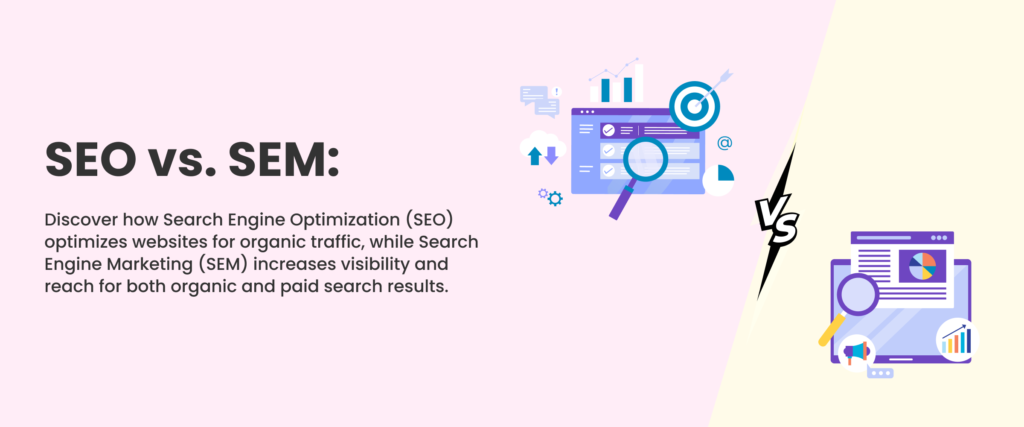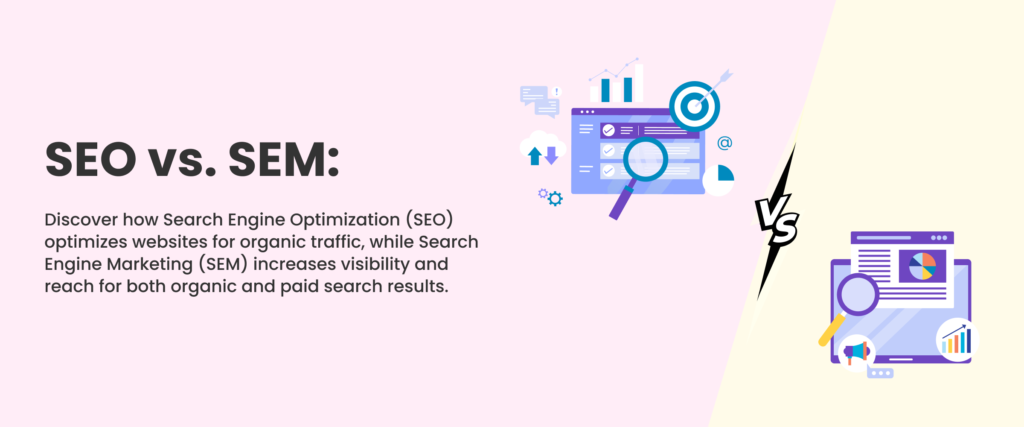Introduction: In the realm of digital marketing, two strategies reign supreme for enhancing online visibility and driving traffic: Search Engine Marketing (SEM) and Search Engine Optimization (SEO). While both aim to improve a website’s performance in search engine results, they employ distinct approaches and tactics. This article delves into the differences between SEM and SEO, elucidating their definitions, methodologies, and strategic implications for businesses seeking to bolster their online presence.

Understanding Search Engine Marketing (SEM)
Search Engine Marketing encompasses paid advertising strategies designed to promote a website’s visibility in search engine results pages (SERPs). SEM involves bidding on keywords and placing advertisements within search engine results or on partner websites through platforms like Google Ads (formerly Google AdWords) and Bing Ads.
Key Characteristics of SEM:
- Paid Placement: SEM involves paying for ad placement on search engine results pages or partner websites.
- Immediate Results: SEM campaigns can yield immediate results in terms of increased visibility and website traffic.
- Cost-Per-Click (CPC) Model: Advertisers pay a fee each time a user clicks on their ad, with costs varying based on keyword competitiveness and bidding strategies.
Understanding Search Engine Optimization (SEO)
Search Engine Optimization focuses on improving a website’s organic visibility in search engine results through unpaid methods. SEO involves optimizing website content, structure, and backlink profile to align with search engine algorithms and improve rankings for relevant keywords.
Key Characteristics of SEO:
- Organic Visibility: SEO aims to improve a website’s organic (unpaid) visibility in search engine results.
- Long-Term Strategy: SEO is a long-term strategy that requires ongoing optimization and monitoring to maintain and improve rankings.
- Quality Content and Backlinks: SEO emphasizes the creation of high-quality content and the acquisition of authoritative backlinks to improve website authority and relevance.
Contrasting SEM and SEO
- Paid vs. Organic: The primary distinction between SEM and SEO lies in their approach to achieving visibility in search engine results. SEM relies on paid advertising, while SEO focuses on optimizing organic search visibility.
- Immediate vs. Long-Term Results: SEM campaigns can deliver immediate results in terms of increased visibility and website traffic, whereas SEO is a long-term strategy that requires sustained effort to improve rankings gradually.
- Cost Structure: SEM operates on a cost-per-click (CPC) model, where advertisers pay for each click on their ads. In contrast, SEO does not involve direct costs for clicks but requires investment in content creation, optimization, and link-building efforts.
- Control and Flexibility: SEM offers greater control and flexibility over ad placement, targeting, and budget allocation, allowing advertisers to adjust campaigns in real-time. SEO, on the other hand, is subject to search engine algorithms and may take time to see results from optimization efforts.
Strategic Implications for Businesses
- Budget Allocation: Businesses must consider their budget constraints and marketing goals when deciding between SEM and SEO. While SEM offers immediate visibility with paid advertising, SEO provides long-term value through organic search optimization.
- Complementary Strategies: SEM and SEO can complement each other effectively in a comprehensive digital marketing strategy. Businesses can use SEM to capture immediate traffic and supplement it with SEO efforts for sustained organic visibility.
- Measurement and Analysis: Both SEM and SEO require ongoing measurement, analysis, and optimization to maximize results. Businesses should track key performance indicators (KPIs) such as click-through rates (CTR), conversion rates, and return on investment (ROI) to assess the effectiveness of their campaigns.
Conclusion
In conclusion, while SEM and SEO share the common goal of improving a website’s visibility in search engine results, they employ distinct strategies and tactics to achieve this objective. SEM leverages paid advertising for immediate visibility, while SEO focuses on optimizing organic search rankings over the long term. Understanding the differences between SEM and SEO is essential for businesses seeking to develop a holistic digital marketing strategy and maximize their online presence. By leveraging the unique strengths of SEM and SEO and aligning them with their marketing objectives, businesses can enhance their visibility, drive traffic, and achieve sustainable growth in the competitive landscape of digital marketing.
